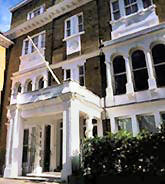Supported by G C W Warr, Professor of Classics at King’s College London, and the Principal Alfred Barry, from 1878 lectures for ladies were held in the old town hall in Kensington.

Attendance outgrew the lecture rooms, which in 1879 were moved to a house in Observatory Avenue, Kensington. From 1881 moves were made to found a ladies’ department of King’s College based on this initiative, with the necessary statutory powers obtained by an Act of Parliament which received the royal assent in 1882. The Ladies’ Department was inaugurated in 1885 at no 13 Kensington Square. It was to be administered, under the Council of King’s College, by an executive committee. The principal of King’s College was head of the department, with a lady superintendent (from 1891 known as the vice principal) as his deputy in Kensington Square.

The department’s function at this period was not to prepare its students for definite professional careers, but to give them a taste of a liberal education. Under Lilian Faithfull as vice-principal (1894-1907) the department developed the character of a university college. In 1898 the application for the admission of women to the King’s College associateship was granted by the Council. From 1902 the department was known as the Women’s Department, and students took examinations for London University degrees and Oxford or Cambridge diplomas.
A movement for university education in home science, although controversial among educationists, resulted in courses (Home Science and Economics) starting in 1908. At that period the policy of the department, with the concurrence of the Delegacy of King’s College and the Senate of the University, was to establish on a new site in Kensington a complete university college for women. Under the King’s College London Transfer Act (1908), in 1910 the Women’s Department was incorporated in the University of London with a distinct existence as King’s College for Women. Owing to pressure on space from increasing numbers, nos 11 and 12 Kensington Square were added to the College’s premises in 1911-1912. In 1913 a special delegacy for King’s College for Women was constituted by the Senate of the University of London. However, in 1913 the Haldane report of the Royal Commission on the University of London unexpectedly recommended that the Home Science Department alone should be developed in Kensington.

On a new site at Campden Hill, Kensington (the Blundell Hall estate), originally intended for the whole of King’s College for Women, buildings for the Household and Social Science Department (after 1928 King’s College for Household and Social Science) were begun in 1914 and went into use in 1915, while other departments were amalgamated with King’s College on the Strand site. The conversion of King’s College to a co-educational institution by the absorption of King’s College for Women was agreed in 1914 and the arts and science departments moved from Kensington Square to the Strand in January 1915. The number of women students began to increase rapidly and in 1921 King’s College Hostel for Women opened in Bayswater, subsequently expanded from time to time by taking in adjoining houses.
In 1928 the department became completely independent as King’s College of Household and Social Science and the title King’s College for Women was extinguished. The buildings were completed in 1930. The College had a pioneering role in establishing nutritional science as a subject of academic scholarship and John Yudkin was a Professor from 1945 to 1971. A Royal Charter was granted in 1953, the name changed to Queen Elizabeth College, men were admitted, and the existing degree was replaced with BSc (Nutrition) and BSc (Household Science). Recognition as a School of the University of London in the Faculty of Science was granted in 1956. The BSc (General) began in 1957.
Following financial difficulties the amalgamation of the College with King’s College London and Chelsea College was completed in 1985.
Further information on the history of QEC can be found on the QEC and Chelsea College Archive at Kings College.

This picture shows the remains of the Atkins building in 2003, with QEC in the background.